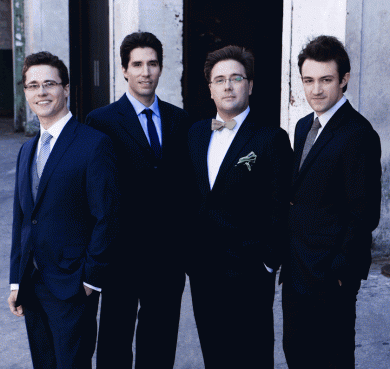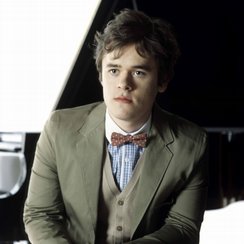Grosvenor and Escher Quartet prove rewarding separately, mixed together

The Escher String Quartet performed with pianist Benjamin Grosvenor Tuesday night at Gusman Concert Hall.
Two rising stars of classical music – pianist Benjamin Grosvenor and the Escher String Quartet – joined forces Tuesday night for Friends of Chamber Music of Miami’s final concert of its 2013-14 season. Both have garnered top classical music awards, including a 2013 Avery Fischer Career Grant for Escher, and Gramophone’s 2012 ‘Young Artist of the Year’ for Grosvenor. FOCM has successfully grown their audience, and Gusman Concert Hall was respectably full.
Youthful exuberance propelled the program, showcasing the 30-something Escher Quartet members and 21 year-old Grosvenor separately on the first half and in collaboration with Antonin Dvorak’s Piano Quintet No. 2 in A major on the second half.
Escher’s bold opening choice was contemporary French composer Henri Dutilleux’s uncompromising quartet Ainsi la Nuit from 1976. The seven-movement cycle’s kaleidoscopic shifts and extended techniques embellish thick, shimmery chords, suggesting night through mild harmonic murkiness. Cricket chirps, scurrying figures, and starry plucked notes dot the surface, for an evocative but challenging experience. Escher’s luminous transparency and seamless transitions between the fused quartet and individual players provided the best performance of the night.
British phenom Benjamin Grosvenor made his Miami solo debut in 2012 on FOCM’s series, and continues to mature as a soloist. Technically clean and most potent in quiet, introspective passages, he now possesses deeper poignancy, evident in Franz Schubert’s beloved Impromptu in G-flat major, Op. 90, No. 3.
Whenever crescendos threatened his musical statement, Grosvenor reined in the tender melody and gently rippling left hand arpeggios. He still tends to hunch over the keys possessively, conveying an impression that the audience is trespassing on an intimate moment, but the audience reception was enthusiastic.
In Felix Mendelssohn’s Andante & Rondo capriccioso, Grosvenor’s singing melody did not overshadow the more complex, sparkling textures of the Rondo’s opening. A Romantic interpretation of the simpler sections provided a foil for his faster passagework.
Navigating the diabolical opening octaves skillfully, Grosvenor delivered a sculpted rendition of Charles Gounod’s Valse de Faust via dynamics and tone color. However, his elegant grace in quieter passages still outshone his fire in the opening and closing sections.
Dvorak’s Piano Quintet proved less successful. The fierce opening of the Allegro ma non tanto had a wiry cello tone and rough-edged, muddy balance. The repeat was much improved, clearly delineating alternating melancholy solos and fiery ensemble work. Opposing joyous melodies and searching minor phrases characterized an even better development section.
The epic Dumka movement was distinguished by violist Pierre Lapointe’s colorfully rich, folk-inflected melodies. Tasteful embellishment by Grosvenor was answered by a meatier, Bohemian tone from the strings. Contrasting genteel, dancelike sections, and a moment of light, strict-tempo unisons provided brilliant effects, but intonation issues in the strings marred Grosvenor’s extended solos.
The musicians took a Classical approach to the briskly compact Furiant with precise execution. An exquisite pastorale painted a playful, nostalgic countryside, for the best moments of the quintet.
However, in the finale, the Allegro’s repetitive question-and-answer passages suffered from homogeneity of dynamics and phrasing, lacking the third movement’s captivating spark. A brief fugato’s swift lines and a serene late section provided some needed respite, for an overall mixed Dvorak performance.
Posted in Performances
Leave a Comment
Wed May 7, 2014
at 11:44 am
No Comments







